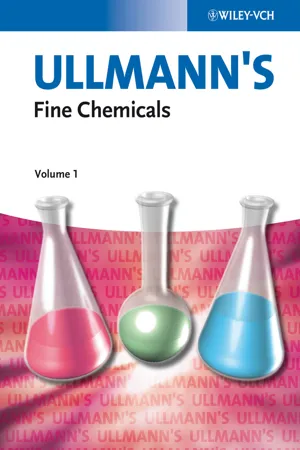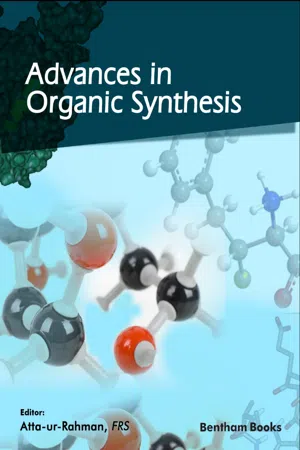Chemistry
Nitriles
Nitriles are organic compounds containing a cyano group (C≡N). They are commonly used in organic synthesis and industrial processes. Nitriles can be found in various natural products and are important intermediates in the production of pharmaceuticals, agrochemicals, and plastics. Their versatile reactivity makes them valuable building blocks for the preparation of diverse chemical compounds.
Written by Perlego with AI-assistance
4 Key excerpts on "Nitriles"
- eBook - ePub
- (Author)
- 2014(Publication Date)
- Wiley-VCH(Publisher)
Nitriles Peter Pollak, Lonza AG, Basel, Switzerland Gérard Romeder, Lonza AG, Basel, Switzerland Ferdinand Hagedorn, Bayer AG, Leverkusen, Federal Republic of Germany Heinz-Peter Gelbke, BASF Aktiengesellschaft, Ludwigshafen, Federal Republic of Germany1. Introduction
Organic compounds containing the – CN group are generically called Nitriles. The term “nitrile” refers to the triply bound nitrogen atom, ≡ N, and not to the carbon atom attached to it; therefore numbering of the aliphatic chain starts with that carbon atom (e.g., 4-chlorobutyronitrile describes the chemical formula ClCH2 CH2 CH2 CN).Nitriles R – CN are usually viewed as derivatives of the corresponding acids R – COOH. Consequently, they are also named by changing the ending “ic acid” or “oic acid” to “onitrile” (e.g., glutaric acid → glutaronitrile; dodecanoic acid → dodecanonitrile, propiononitrile, as an exception, is commonly referred to as propionitrile). Another way of naming Nitriles is to state the name of the group R and use the prefix “cyano” or the suffix “cyanide” (e.g., cyanoethane and ethyl cyanide both describe H3 CCH2 CN). Nitriles that are obtained by addition of hydrogen cyanide to ketones or aldehydes and thus have both a hydroxy and a cyano group attached to the same carbon atom are commonly termed cyanohydrins (e.g., acetone cyanohydrin is identical to 2-hydroxy-2-methylpropionitrile). The same nomenclature applies to 3-hydroxypropionitrile which is commonly named ethylene cyanohydrin.2. Aliphatic Nitriles
Aliphatic Nitriles are important starting materials for polymers as well as for the synthesis of e.g., pharmaceuticals and pesticides.2.1. Physical Properties
The carbon – nitrogen bond is extremely polar, which results in Nitriles having a high dipole moment. This large dipole moment leads to intramolecular association; hence, Nitriles have higher boiling points than would be expected from their molecular mass. Most of the lower molecular mass aliphatic Nitriles (up to C13 H27 CN) are liquids at room temperature. Simple Nitriles such as acetonitrile, propionitrile, glycolonitrile, and malononitrile are miscible with water; the latter two having a higher solubility because of the presence of two polar groups. Nitriles with higher molecular mass are sparingly water-soluble. Nitriles are good solvents for both polar and nonpolar solutes. The physical properties of selected Nitriles are listed in Table 1 - eBook - ePub
- Atta-ur-Rahman(Author)
- 2021(Publication Date)
- Bentham Science Publishers(Publisher)
4 ].Scheme (1)) Some methods for the preparation of Nitriles: Ammoxidation (A), hydrocyanation (B), Cyanohydrin formation, (C), and Sandmeyer Reaction (D).Besides their application in polymers, Nitriles are also present in more than 30 pharmaceuticals, including antidepressants, antidiabetics, and anticancer drugs (Fig.Fig. (1)) Example of Nitrile-containing compounds in clinical use.), since they can act as hydrogen acceptors, increase water solubility and shield the drug from oxidative metabolism [5 - 8 ].1Moreover, the majority of Nitriles are relatively stable and inexpensive compounds that support a high variation of substituents and can be converted into many functional groups (SchemeScheme (2)) Example of the conversion of Nitriles into some common functional groups: ketone (A), carboxylic acid (B), aldehyde (C), and amine (D).) and heterocycles by various processes. Therefore, Nitriles are interesting reagents in the synthesis of robust and diverse molecular libraries that may be used in high throughput screening assays on the search for novel drug candidates [9 , 10 ].2Five membered-ring azaheterocycles have been extensively explored in medicinal chemistry and are present in many marketed drugs. Some of them, such as pyrrole, indole, triazole, and imidazole are found in top-selling drugs [11 , 12 ] and many more are found in bioactive molecules [13 , 14 ].Therefore, considering the importance of the nitrile functional group as a precursor to many azaheterocycles, in this work we will review the new synthetic methodologies, reported from 2014 to 2020, for the synthesis of some prominent 5-membered azaheterocycles via - eBook - ePub
Toxicology of Cyanides and Cyanogens
Experimental, Applied and Clinical Aspects
- Alan H. Hall, Gary E. Isom, Gary A. Rockwood, Alan H. Hall, Gary E. Isom, Gary A. Rockwood(Authors)
- 2015(Publication Date)
- Wiley-Blackwell(Publisher)
Chapter 12 Cyanogenic aliphatic Nitriles Stephen W. BorronAt a Glance
- Aliphatic Nitriles exist as monoNitriles (with 1 cyanide moiety) or diNitriles (with 2 cyanide moieties).
- Aliphatic Nitriles are widely used in industry for a variety of applications.
- While the parent aliphatic nitrile compounds may have their own toxicity, metabolic release of cyanide after systemic absorption by the oral, inhalational, or dermal routes accounts for the majority of their toxicity.
- The onset of cyanide poisoning signs and symptoms is often delayed, and toxic manifestations may recur due to continued metabolic release of cyanide.
- Human poisonings have been reported with acetonitrile, adiponitrile, isobutyronitrile, glycolonitrile, lactonitrile, propionitrile, succinonitrile, and acetone cyanohydrin.
- Specific cyanide antidotes have been efficacious in cases of human aliphatic nitrile poisoning; the most clinical experience has been with sodium thiosulfate, alone or in combination with other cyanide antidotes.
12.1 Overview
This chapter addresses some aliphatic Nitriles of industrial importance, essentially excluding acrylonitrile, which is covered in Chapter 13 . Cyanogenic glycosides, including those found in foodstuffs, such as cassava, and in drugs, such as laetrile, are not discussed here.Aliphatic Nitriles have the general formula R-CN and exist as monoNitriles and diNitriles (one and two functional groups, respectively). The closely related cyanohydrins have a general formula of (see Figure 12.1 ). The Nitriles are an extremely important chemical family, employed as solvents (acetonitrile, propionitrile), in the manufacture of plastics and synthetic rubber (acrylonitrile, adiponitrile), in drug manufacture (acetonitrile, glycolonitrile, propionitrile), in petroleum refining and hydrocarbon extraction (acetonitrile, propionitrile) and as intermediates in the manufacture of other chemicals (ketones, esters) and fibers. Some of the important physical properties of Nitriles involved in human poisonings are found in Table 12.1 . More than 40 Nitriles appear in the U.S. Environmental Protection Agency's High Production Volume Information System (HPVIS), indicating that quantities of 1,000,000 pounds or more of these chemicals are produced or imported each year into the United States (Table 12.2 - eBook - ePub
- Graham Patrick(Author)
- 2004(Publication Date)
- Taylor & Francis(Publisher)
2 hybridized imine anion which then reacts further to give different products depending on the reaction conditions used.Figure 2. Reaction between nucleophile and Nitriles.Reactions
Nitriles (RCN) are hydrolyzed to carboxylic acids (RCO2 H) in acidic or basic aqueous solutions. The mechanism of the acid-catalyzed hydrolysis (Figure 3 ) involves initial protonation of the nitrile's nitrogen atom. This activates the nitrile group towards nucleophilic attack by water at the electrophilic carbon. One of the nitrile π bonds breaks simultaneously and both the π electrons move onto the nitrogen resulting in a hydroxy imine. This rapidly isomerizes to a primary amide which is hydrolyzed under the reaction conditions (Section K6 ) to give the carboxylic acid and ammonia.Figure 3. Acid-catalyzed hydrolysis of nitrile to primary amide (further hydrolysis to carboxylic acid ensues).Nitriles (RCN) can be reduced to primary amines (RCH2 NH2 ) with lithium aluminum hydride which provides the equivalent of a nucleophilic hydride ion. The reaction can be explained by the nucleophilic attack of two hydride ions (Figure 4 ).Figure 4. Reduction of Nitriles to form primary amines. With a milder reducing agent such as DIBAH (diisobutylaluminum hydride), the reaction stops after the addition of one hydride ion, and an aldehyde is obtained instead (RCHO).Grignard reaction
Nitriles can be treated with Grignard reagents or organolithium reagents (Section L7 ) to give ketones (Figure 5 ).Figure 5. Nitriles react with Grignard reagent or organolithium reagents to produce ketones.
Index pages curate the most relevant extracts from our library of academic textbooks. They’ve been created using an in-house natural language model (NLM), each adding context and meaning to key research topics.
Explore more topic indexes
Explore more topic indexes
1 of 6
Explore more topic indexes
1 of 4



